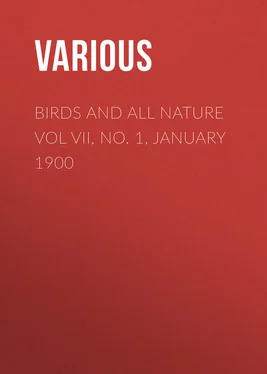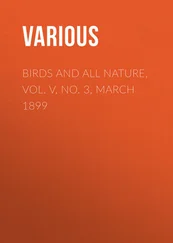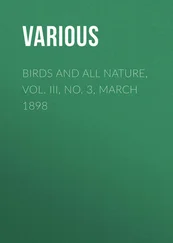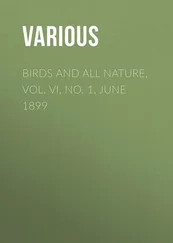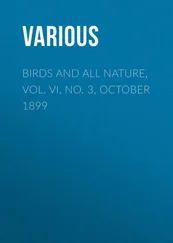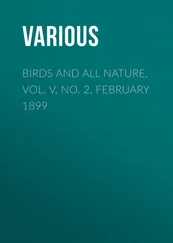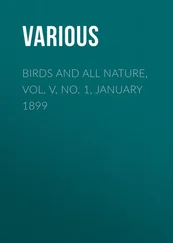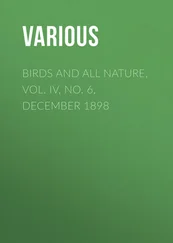Various - Birds and All Nature Vol VII, No. 1, January 1900
Здесь есть возможность читать онлайн «Various - Birds and All Nature Vol VII, No. 1, January 1900» — ознакомительный отрывок электронной книги совершенно бесплатно, а после прочтения отрывка купить полную версию. В некоторых случаях можно слушать аудио, скачать через торрент в формате fb2 и присутствует краткое содержание. Жанр: periodic, Биология, Природа и животные, foreign_edu, на английском языке. Описание произведения, (предисловие) а так же отзывы посетителей доступны на портале библиотеки ЛибКат.
- Название:Birds and All Nature Vol VII, No. 1, January 1900
- Автор:
- Жанр:
- Год:неизвестен
- ISBN:нет данных
- Рейтинг книги:4 / 5. Голосов: 1
-
Избранное:Добавить в избранное
- Отзывы:
-
Ваша оценка:
- 80
- 1
- 2
- 3
- 4
- 5
Birds and All Nature Vol VII, No. 1, January 1900: краткое содержание, описание и аннотация
Предлагаем к чтению аннотацию, описание, краткое содержание или предисловие (зависит от того, что написал сам автор книги «Birds and All Nature Vol VII, No. 1, January 1900»). Если вы не нашли необходимую информацию о книге — напишите в комментариях, мы постараемся отыскать её.
Birds and All Nature Vol VII, No. 1, January 1900 — читать онлайн ознакомительный отрывок
Ниже представлен текст книги, разбитый по страницам. Система сохранения места последней прочитанной страницы, позволяет с удобством читать онлайн бесплатно книгу «Birds and All Nature Vol VII, No. 1, January 1900», без необходимости каждый раз заново искать на чём Вы остановились. Поставьте закладку, и сможете в любой момент перейти на страницу, на которой закончили чтение.
Интервал:
Закладка:
Birds and All Nature Vol VII, No. 1, January 1900 / Illustrated by Color Photography
JANUARY
Then came old January, wrapped well
In many weeds to keep the cold away;
Yet did he quake and quiver like to quell,
And blow his nayles to warm them if he may;
For they were numb'd with holding all the day
An hatchet keene, with which he felled wood,
And from the trees did lop the needlesse spray;
Upon a huge great earth-pot steane he stood,
From whose wide mouth there flowed forth the Romane flood.
Announced by all the trumpets of the sky,
Arrives the snow; and, driving o'er the fields,
Seems nowhere to alight; the whited air
Hides hills and woods, the river, and the heaven,
And veils the farm-house at the garden's end.
The sled and traveler stopp'd, the courier's feet
Delay'd, all friends shut out, the house-mates sit
Around the radiant fire-place, inclosed
In a tumultuous privacy of storm.
OLD YEAR AND YOUNG YEAR
Said the year that was old:
"I am cold, I am cold,
And my breath hurries fast
On the wild winter blast
Of this thankless December;
Ah, who will remember
As I, shivering, go,
The warmth and the glow
That arose like a flame
When I came, when I came?
For I brought in my hands,
From Utopian lands,
Golden gifts, and the schemes
That were fairer than dreams.
Ah, never a king
Of a twelvemonth, will bring
Such a splendor of treasure
Without stint or measure,
As I brought on that day,
Triumphant and gay.
But, alas, and alas,
Who will think as I pass,
I was once gay and bold?"
Said the year that was old.
Said the year that was young —
And his light laughter rung —
"Come, bid me good cheer,
For I bring with me here
Such gifts as the earth
Never saw till my birth;
All the largess of life,
Right royally rife
With the plans and the schemes
Of the world's highest dreams.
Then – hope's chalice filled up
To the brim of the cup,
Let us drink to the past,
The poor pitiful past,"
Sang the year that was young,
While his light laughter rung.
THE VIRGINIA RAIL
THIS miniature of Rallus elegans or king rail, is found throughout the whole of temperate North America as far as the British Provinces, south to Guatemala and Cuba, and winters almost to the northern limit of its range. A specimen was sent by Major Bendire to the National Museum from Walla Walla, Wash., which was taken Jan. 16, 1879, when the snow was more than a foot deep. Other names of the species are: Lesser clapper rail, little red rail, and fresh-water mud hen. The male and female are like small king rails, are streaked with dark-brown and yellowish olive above, have reddish chestnut wing coverts, are plain brown on top of head and back of neck, have a white eyebrow, white throat, breast and sides bright rufous; the flanks, wing linings and under tail coverts are broadly barred with dark brown and white; eyes red.
The name of this rail is not as appropriate to-day as it was when Virginia included nearly all of the territory east of the Mississippi. It is not a local bird, but nests from New York, Ohio, and Illinois northward. Short of wing, with a feeble, fluttering flight when flushed from the marsh, into which it quickly drops again, as if incapable of going farther, it is said this small bird can nevertheless migrate immense distances. One small straggler from a flock going southward, according to Neltje Blanchan, fell exhausted on the deck of a vessel off the Long Island coast nearly a hundred miles at sea.
The rail frequents marshes and boggy swamps. The nest is built in a tuft of weeds or grasses close to the water, is compact and slightly hollowed. The eggs are cream or buff, sparsely spotted with reddish-brown and obscure lilac, from 1.20 to 1.28 inches long to .90 to .93 broad. The number in a set varies from six to twelve. The eggs are hatched in June.
The Virginia rail is almost exclusively a fresh-water bird. It is not averse to salt water, but even near the sea it is likely to find out those spots in the bay where fresh-water springs bubble up rather than the brackish. These springs particularly abound in Hempstead and Great South Bay on the south coast of Long Island. Brewster says the voice of the Virginia rail, when heard at a distance of only a few yards, has a vibrating, almost unearthly quality, and seems to issue from the ground directly beneath the feet. The female, when anxious about her eggs or young, calls ki ki-ki in low tones and kiu , much like a flicker. The young of both sexes in autumn give, when startled, a short, explosive kep or kik , closely similar to that of the Carolina rail.
There is said to be more of individual variation in this species than in any of the larger, scarcely two examples being closely alike. The chin and throat may be distinctly white, or the cinnamon may extend forward entirely to the bill. This species is found in almost any place where it can find suitable food. Nelson says: "I have often flushed it in thickets when looking for woodcock, as well as from the midst of large marshes. It arrives the first of May and departs in October; nests along the borders of prairie sloughs and marshes, depositing from eight to fourteen eggs. The nest may often be discovered at a distance by the appearance of the surrounding grass, the blades of which are in many cases interwoven over the nest, apparently to shield the bird from the fierce rays of the sun, which are felt with redoubled force on the marshes. The nests are sometimes built on a solitary tussock of grass, growing in the water, but not often. The usual position is in the soft, dense grass growing close to the edge of the slough, and rarely in grass over eight inches high. The nest is a thick, matted platform of marsh grasses, with a medium-sized depression for the eggs."
Some of the rails have such poor wings that it has been believed by some unthinking people that they turn to frogs in the fall instead of migrating – a theory parallel with that which formerly held that swallows hibernate in the mud of shallow ponds.
COTTON FABRICS
IT is a remarkable thing in the history of the United States that, when the iron shackles were about to fall from the bondman, he was caught by a cotton fiber and held for nearly a century longer. We were about to emancipate the slaves a century ago when Eli Whitney invented the cotton gin, multiplied cotton production by two hundred, and made slavery profitable throughout the South. The South Carolina legislature gave Whitney $50,000 and cotton became king and controlled our commerce and politics.
Eight bags of cotton went out of Charleston for Liverpool in 1784. Now about six million bales go annually, and we keep three million bales for our own use. So two-thirds of our cotton goes to England. The cotton we ship sells for more than all our flour. Cotton is still king.
In our civil war we came very near being thrown into conflict with England by an entanglement of the same fiber which caught the black man. One of the greatest industries of England in 1861-5 was cotton manufacture, and when we, by our blockade system, closed the southern ports so cotton could not be carried out, we nearly shut down all the works in that country where cotton was made up. That meant hard times to many towns and suffering to many families. That is why so many Englishmen said we ought to be satisfied to cut our country in two and let the people of the Confederacy have their way.
Читать дальшеИнтервал:
Закладка:
Похожие книги на «Birds and All Nature Vol VII, No. 1, January 1900»
Представляем Вашему вниманию похожие книги на «Birds and All Nature Vol VII, No. 1, January 1900» списком для выбора. Мы отобрали схожую по названию и смыслу литературу в надежде предоставить читателям больше вариантов отыскать новые, интересные, ещё непрочитанные произведения.
Обсуждение, отзывы о книге «Birds and All Nature Vol VII, No. 1, January 1900» и просто собственные мнения читателей. Оставьте ваши комментарии, напишите, что Вы думаете о произведении, его смысле или главных героях. Укажите что конкретно понравилось, а что нет, и почему Вы так считаете.
